Where We Are Now
Throughout most of the last 10,000 years, the time when human civilizations have developed, the Earth’s climate was relatively stable. Atmospheric levels of CO2 were about 270 ppm, and both sea levels and atmospheric temperatures were relatively constant, with sea levels varying about a meter (three feet) and temperatures varying about .5°F (.9°F). Since about 1880, however, human activities have caused the atmospheric levels of CO2 to rise to about 400ppm, resulting in a temperature increase of about .8°C (1.4°F). And during same time period the oceans have risen about .2 meters (8 inches).
| 1. |
CO2 levels passed 400ppm in 2014 |
| 2. |
The Earth is warming dramatically, and most of the extra heat is going into the oceans |
| 3. |
Only 2.3% of extra heat is warming the atmosphere |
| 5. |
El Nino/La Nina significantly affect atmospheric temperatures |
| 6. |
Extreme rainfall has increased dramatically in the US since 1958 |
| 7. |
The acreage burned by wildfires in the US is increasing |
| 8. |
Ocean pH has declined significantly since 1958 |
| 9. |
Arctic Sea Ice Volume Is Decreasing Rapidly |
| 10. |
Sea levels will rise 80 meters if all glaciers melt |
| 12. |
Antarctica is melting twice as fast as it was 10 years ago |
| 13. |
Greenland ice sheet is melting significantly |
This Fact Page displays text and images related to global warming and climate change
(Hover your mouse over the text below to "popup" a window with a related text.
Click on the text or image to open a new window with a detailed description.)
|
|
| | 1. | | CO2 levels passed 400ppm in 2014 |
The atmospheric concentration of CO2 is continuing to increase at about 3.2ppm/year, having surpassed 400ppm for several months in 2014. 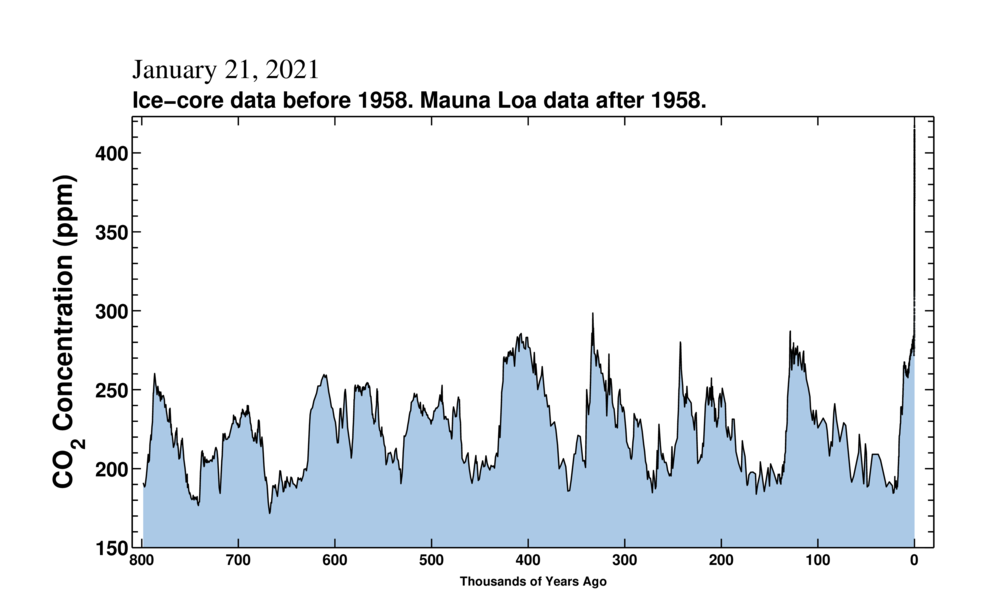 | | | 2. | | The Earth is warming dramatically, and most of the extra heat is going into the oceans |
As a result of the increase in atmospheric CO2, the Earth has been absorbing an excess of about 8 zeta joules of energy/year (the equivalent of a 50 megaton nuclear bomb being exploded every 15 minutes), with almost all of the energy going in to warming the oceans. 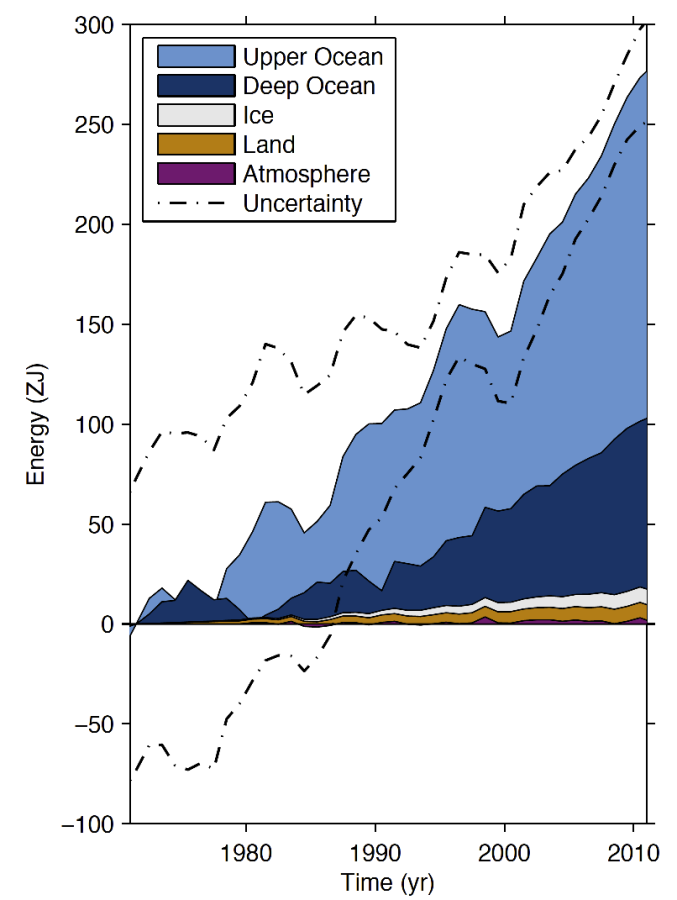 | | | | 3. | | Only 2.3% of extra heat is warming the atmosphere |
Only about 2.3% of the excess energy is used to warm the atmosphere, while about 1.3% is used to melt glaciers and about 0.8% is used to melt Arctic sea ice. 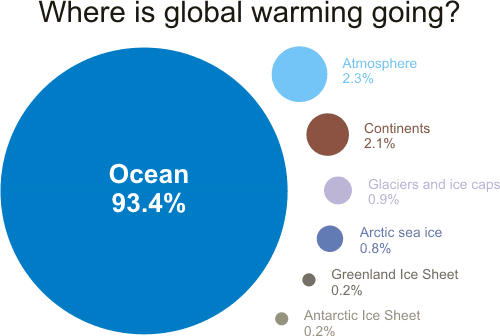 | | | 5. | | El Nino/La Nina significantly affect atmospheric temperatures |
Snce El Nino and La Nina have such an impact on global atmospheric temperatures, the best way to look at the atmospheric temperature change is to categorize the global temperature by “type of year”, which indicates that the atmospheric temperatures have been increasing at the same steady rate (about .16°C /decade) since 1970 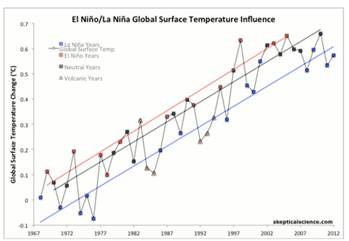 | | | | 6. | | Extreme rainfall has increased dramatically in the US since 1958 |
The warmer atmosphere holds more water (about 4% per degree F) and a likely result has been be the increase in severe precipitation events in the last 50 years in the United States 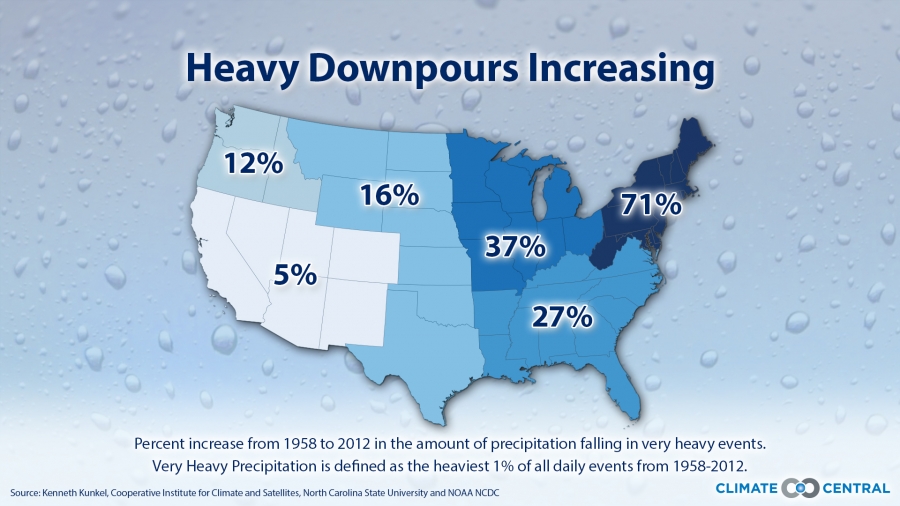 | | | 7. | | The acreage burned by wildfires in the US is increasing |
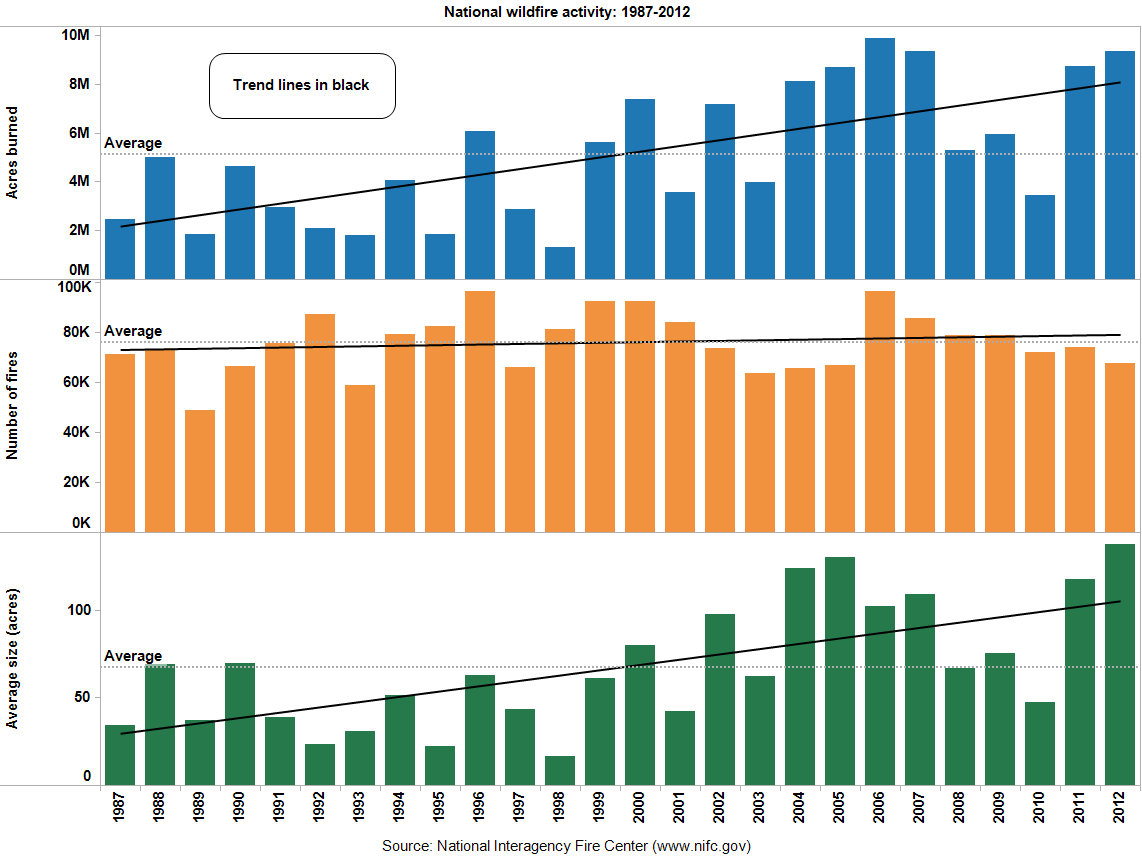 | | | | 8. | | Ocean pH has declined significantly since 1958 |
As a result of the increase in atmospheric CO2, the oceans have become more acidic 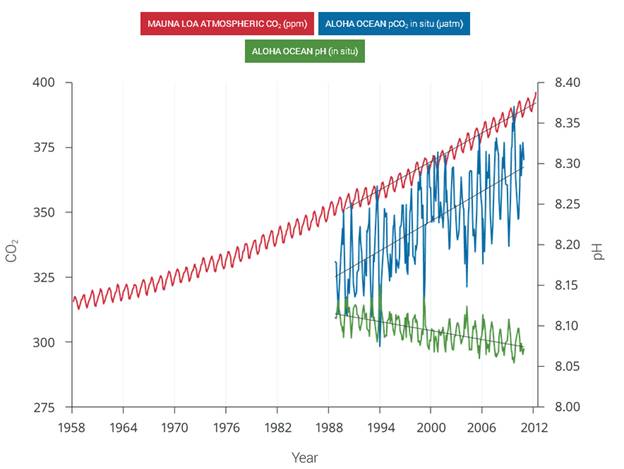 | | | 9. | | Arctic Sea Ice Volume Is Decreasing Rapidly |
As a result of the of the increased Arctic temperatures, the Arctic Ocean is losing very significant amounts of summertime ice volume (ice volume is a better indicator of the melting of the ice in summertime than ice area) 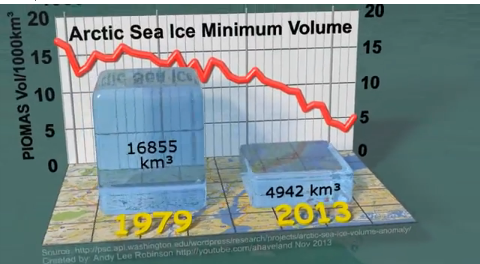 | | | | 10. | | Sea levels will rise 80 meters if all glaciers melt |
If all of glaciers melt the sea level rise will likely be about 80 meters 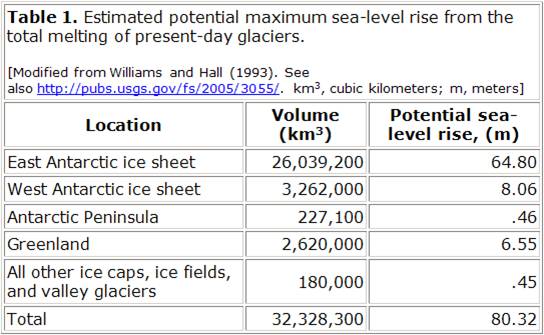 | | | 12. | | Antarctica is melting twice as fast as it was 10 years ago |
Antarctic ice melt is twice as fast as ten years ago 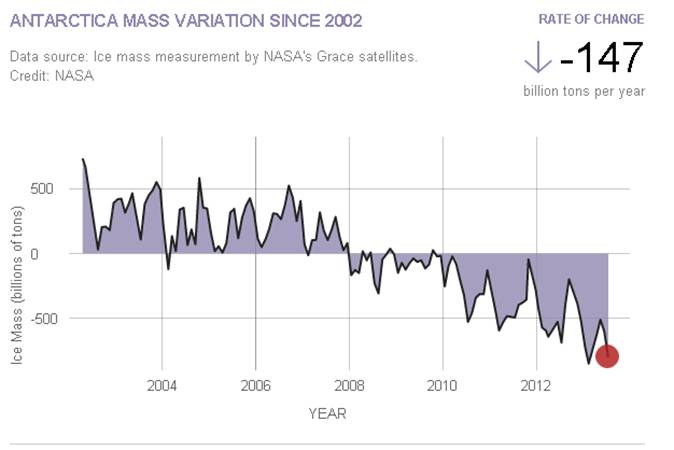 | | | | 13. | | Greenland ice sheet is melting significantly |
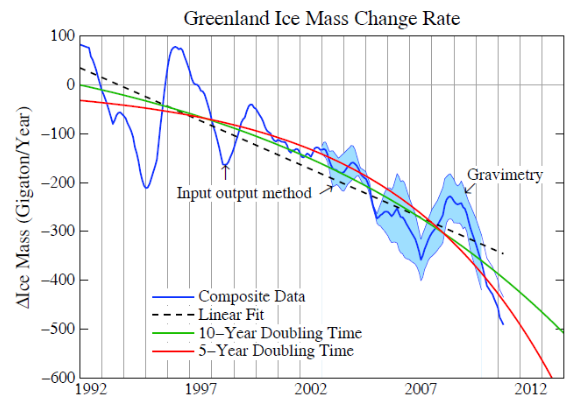 | | | |
CO2 levels passed 400ppm in 2014
| CO2 Concentrations Last 800,000 Years | | The atmospheric concentration of CO2 is continuing to increase at about 3.2ppm/year, having surpassed 400ppm for several months in 2014. |  | | | Source: Scripts | | URL: http://keelingcurve.ucsd.edu/ |
The Earth is warming dramatically, and most of the extra heat is going into the oceans
| Energy absorbed by the Earth 1970-2010 - Most of the heat is going into the oceans | | As a result of the increase in atmospheric CO2, the Earth has been absorbing an excess of about 8 zeta joules of energy/year (the equivalent of a 50 megaton nuclear bomb being exploded every 15 minutes), with almost all of the energy going in to warming the oceans. | 
(Box 3.1 Fig 1) Plot of energy accumulation in zettajoules within distinct components of Earth’s climate system relative to 1971 and from 1971–2010 unless otherwise indicated. Ocean warming (heat content change) dominates, with the upper ocean (light blue, above 700 m) contributing more than the deep ocean (dark blue, below 700 m; including below 2000 m estimates starting from 1992). Ice melt (light grey; for glaciers and ice caps, Greenland and Antarctic ice sheet estimates starting from 1992, and Arctic sea ice estimate from 1979–2008); continental (land) warming (orange); and atmospheric warming (purple; estimate starting from 1979) make smaller contributions. Uncertainty in the ocean estimate also dominates the total uncertainty (dot-dashed lines about the error from all five components at 90% confidence intervals). | The oceans have a huge thermal mass compared to the atmosphere and land surface. They act as the planet’s heat storage and transportation system, as the ocean currents redistribute the heat. This is important because if we look at the global surface temperature as an indication of warming, we’re only getting some of the picture. The oceans act as a huge storage heater, and will continue to warm up the lower atmosphere (no matter what changes we make to the atmosphere in the future). | | | Source: johncarlosbaez | URL: http://johncarlosbaez.wordpress.com/2014/04/11/what-does-the-new-ipcc-report-say-about-climate-change-part-4/
(The text for the image(s) on this Web page was taken from the above source.) |
Only 2.3% of extra heat is warming the atmosphere
| Where is global warming going | | Only about 2.3% of the excess energy is used to warm the atmosphere, while about 1.3% is used to melt glaciers and about 0.8% is used to melt Arctic sea ice. | 
Figure 1: components of global warming for the period 1993 to 2003 calculated from IPCC AR4 5.2.2.3. | The percentages were calculated from Figure 5.4 from Section 5.2.2.3 of the IPCC 4th Assessment Report (h/t to Humanity Rules for the heads up). The IPCC graph shows changes in energy content for two different periods: 1961 to 2003 and 1993 to 2003. The ocean heat figure of 93.4% is almost certainly an underestimate as it only includes ocean heat down to 700 metres (Levitus 2005). | | URL: http://www.skepticalscience.com/Where-is-global-warming-going.html
(The text for the image(s) on this Web page was taken from the above source.) |
El Nino/La Nina significantly affect atmospheric temperatures
| El Niño/La Niña Global Surface Temperature Influence - 1967-2012 | | Snce El Nino and La Nina have such an impact on global atmospheric temperatures, the best way to look at the atmospheric temperature change is to categorize the global temperature by “type of year”, which indicates that the atmospheric temperatures have been increasing at the same steady rate (about .16°C /decade) since 1970 |  | | | Source: wunderground.com | | URL: http://www.wunderground.com/blog/JeffMasters/comment.html?entrynum=2374 |
Extreme rainfall has increased dramatically in the US since 1958
| Increase in Extreme Precipitation Events 1958-2012 | | The warmer atmosphere holds more water (about 4% per degree F) and a likely result has been be the increase in severe precipitation events in the last 50 years in the United States |  | If you get the feeling that heavy downpours are more intense than they used to be, you’re not imagining it. According to the National Climate Assessment, the most extreme precipitation events (those in the 99th percentile of intensity) have increased in every region of the contiguous states since the 1950s. As the map above shows, the rise in intensity has been greatest in the Northeast and least in the Southwest — and in all cases, climate scientists believe, the reason is simple: in a world warmed by heat-trapping greenhouse gases, there’s more evaporation, and the atmosphere can hold on to more water. And when that water vapor condenses as rain or snow, there’s more of it. | | | Source: climatecentral | URL: https://www.climatecentral.org/gallery/maps/extreme-precipitation-events-are-on-the-rise
(The text for the image(s) on this Web page was taken from the above source.) |
The acreage burned by wildfires in the US is increasing
Ocean pH has declined significantly since 1958
| Ocean pH vs Atmospheric ppm 1958 to 2012 | | As a result of the increase in atmospheric CO2, the oceans have become more acidic | 
Figure 2.30: The correlation between rising levels of CO2 in the atmosphere (red) at Mauna Loa and rising CO2 levels (blue) and falling pH (green) in the nearby ocean at Station Aloha. As CO2 accumulates in the ocean, the water becomes more acidic (the pH declines). (Figure source: modified from Feely et al. 2009). | As human-induced emissions of carbon dioxide (CO2) build up in the atmosphere, excess CO2 is dissolving into the oceans where it reacts with seawater to form carbonic acid, lowering ocean pH levels (“acidification”) and threatening a number of marine ecosystems. Currently, the oceans absorbs about a quarter of the CO2 humans produce every year. Over the last 250 years, the oceans have absorbed 560 billion tons of CO2, increasing the acidity of surface waters by 30%.,, Although the average oceanic pH can vary on interglacial timescales, the current observed rate of change is roughly 50 times faster than known historical change., Regional factors such as coastal upwelling, changes in discharge rates from rivers and glaciers, sea ice loss, and urbanization have created “ocean acidification hotspots” where changes are occurring at even faster rates. The acidification of the oceans has already caused a suppression of carbonate ion concentrations that are critical for marine calcifying animals such as corals, zooplankton, and shellfish. Many of these animals form the foundation of the marine food web. Today, more than a billion people worldwide rely on food from the ocean as their primary source of protein. Ocean acidification puts this important resource at risk.
Observations have shown that the northeastern Pacific Ocean, including the Arctic and sub-Arctic seas, is particularly susceptible to significant shifts in pH and calcium carbonate saturation levels. Recent analyses show that large areas of the oceans along the U.S. west coast,, the Bering Sea, and the western Arctic Ocean, will become difficult for calcifying animals within the next 50 years. In particular, animals that form calcium carbonate shells, including corals, crabs, clams, oysters, and tiny free-swimming snails called pteropods, could be particularly vulnerable, especially during the larval stage.,,, | | | Source: National Climate Assessment | URL: http://nca2014.globalchange.gov/report/our-changing-climate/ocean-acidification
(The text for the image(s) on this Web page was taken from the above source.) |
Arctic Sea Ice Volume Is Decreasing Rapidly
| Arctic Ice Volume in September - 1979-2013 | | As a result of the of the increased Arctic temperatures, the Arctic Ocean is losing very significant amounts of summertime ice volume (ice volume is a better indicator of the melting of the ice in summertime than ice area) | 
Artic sea ice volume has dropped far faster than coverage. In September the ice that remains is down by nearly 80% from its volume in 1980. At current pace of volume loss, the first ice-free Arctic day could come in just a few years. | Sea ice volume is a measurement of ice extent and its thickness. Understanding how fast the ice is being depleted by volume is crucial to working out how quickly we are approaching an ice-free Arctic summertime because thinner ice can be more vulnerable to future melting. As one expert noted, “there comes a point when large parts of the ice pack become so thin that it doesn't matter what the weather does…the train keeps chugging along, even when the weather isn't so great for melt”.
As with sea ice extent, volume appears to be in sharp decline in the Arctic. Although ice volume naturally increases and decreases during the seasons, scientists using the Pan-Arctic Ice Ocean Modelling and Assimilation System (PIOMAS) have identified that the amount of ice has been steadily falling since the 1970s.
In addition, the link between disappearing ice and temperature in modern times is now becoming much clearer. NOAA has said that the Arctic “has reached a new state…characterised by less sea ice (both extent and thickness),” adding that “the decline in total sea ice extent has been accompanied by an unprecedented loss of old, thick multiyear ice.”Or, as one commentator noted, Arctic sea ice loss is now “being driven by human emissions.Click here for the source | | | Source: ClimateState | | URL: http://climatestate.com/2013/11/22/arctic-sea-ice-minimum-volumes-1979-2013/ |
Sea levels will rise 80 meters if all glaciers melt
| Estimated potential maximum sea-level rise from the total melting of present-day glaciers | | If all of glaciers melt the sea level rise will likely be about 80 meters |  | If Earth’s climate continues to warm, then the volume of present-day ice sheets will decrease. Melting of the current Greenland ice sheet would result in a sea-level rise of about 6.5 meters; melting of the West Antarctic ice sheet would result in a sea-level rise of about 8 meters (table 1). The West Antarctic ice sheet is especially vulnerable, because much of it is grounded below sea level. Small changes in global sea level or a rise in ocean temperatures could cause a breakup of the two buttressing ice shelves (Ronne/Filchner and Ross). The resulting surge of the West Antarctic ice sheet would lead to a rapid rise in global sea level. Reduction of the West Antarctic and Greenland ice sheets similar to past reductions would cause sea level to rise 10 or more meters. A sea-level rise of 10 meters would flood about 25 percent of the U.S. population, with the major impact being mostly on the people and infrastructures in the Gulf and East Coast States (fig. 3). Researchers at the U.S. Geological Survey and elsewhere are investigating the magnitude and timing of sea-level changes during previous interglacial intervals. Better documentation and understanding of these past changes will improve our ability to estimate the potential for future large-scale changes in sea level. | | | Source: USGS | URL: http://pubs.usgs.gov/fs/fs2-00/
(The text for the image(s) on this Web page was taken from the above source.) |
Antarctica is melting twice as fast as it was 10 years ago
| Antarctic ice melt is twice as fast as ten years ago | | Antarctic ice melt is twice as fast as ten years ago | 
Image source: http://climate.nasa.gov/vital-signs/land-ice/ | 'Antarctic ice losses have DOUBLED in less than a decade with 159 billion tonnes of ice melting each year', reads today's Daily Mail headline. The Guardian opts for, 'Doubling of Antarctic ice loss revealed by European satellite'. The Times says 'Antarctic melt rate worries scientists'.
All three headlines stem from a paper published yesterday in Geophysical Research Letters, which finds the volume of ice melting into the ocean from Antarctica is twice as large the average between 1992 and 2011, now raising global sea levels by 0.45 millimetres a year.
The University of Leeds scientists study uses three years of data from the European Space Agency's CryoSat-2 satellite, launched in 2010. The satellite now sees five times as much area as before, totalling 96 per cent of the total Antarctic continent.
David Vaughan from the British Antarctic Survey told The Guardian why this is so important:
"Through some very clever technical improvements, [the scientists] have produced the best maps of Antarctic ice-loss we have ever had. Prediction of the rate of future global sea-level rise must be begin with a thorough understanding of current changes in the ice sheets - this study puts us exactly where we need to be."
Across Antarctica, the average height of the ice is dropping by 1.9 centimetres per year, the data shows. East Antarctica is staying roughly the same but West Antarctica is seeing big losses, where ice melt is 31 per cent faster now than between 2005 and 2011. Ice loss from glaciers along the Amundsen coast has tripled over the past two decades, the paper explains. | | | Source: carbonbrief | URL: http://www.carbonbrief.org/blog/2014/05/ice-picks-five-pieces-of-ice-news-revealing-earth%E2%80%99s-ice-cover-is-in-serious-decline/
(The text for the image(s) on this Web page was taken from the above source.) |
Greenland ice sheet is melting significantly
| Greenland Ice Sheet Mass 1992 - 2012 | 
Is Climate Change causing an exponential rate of Ice sheet Mass Loss, sea level rise? | Climate scientist James Hansen and his colleague Makiko Sato have released a new discussion paper with updated data on ice sheet mass loss from Greenland and Antarctica, with implications for possible multi-metre sea level rise this century. It makes for some interesting reading - there is a link to Hansen's website and the paper at the end.
The thesis that Hansen has put forward for several years is that Ice Sheet collapse is a non-linear process: that with the inclusion of amplifying climate feedbacks it is likely to follow an exponential rate of acceleration - a doubling rate. It might be a 10 year doubling time, or less. This will lead to extensive sea level rise, perhaps in the order of 5 metres this century.
But accurate data measurements of ice mass loss via laboriously estimating mass input and output has only been available since the early 1990s, and accurate satellite measurements (Gravimetry) via the GRACE satellites since 2000.
What these measurements show is that ice mass loss from both Greenland and Antarctica are accelerating, but the data for the time period is still too short to determine whether ice sheet mass loss will follow a somewhat linear path, or an exponential path doubling every 10 years or shorter time period. | | URL: http://takvera.blogspot.com/2012_12_01_archive.html
(The text for the image(s) on this Web page was taken from the above source.) |
|
|